Knowledge is power and choosing the right metrics to know the right information about your target audience is a boon to any ecommerce website. Ecommerce stores each day try to figure out new ways to increase their online sales and boost the growth of their business. What helps them in the process is the enormous amount of customer data that drives their marketing and promotional decision. This big data is invaluable for ecommerce business for a variety of reason which includes behavioral targeting, ecommerce personalization, customer satisfaction, dynamic pricing and end to end analytics. Good businesses know that customer data is available but for them, as rightly said by John Allen Paulos, “Data, data everywhere but not a thought to think”. On the other hand, smart businesses pay close attention to data and evolve their business models with changing trends to achieve sustainable growth.
Data metric vs KPI
While many business owners believe KPIs and metrics to be the same, it isn’t really true. Metrics and KPIs are analogous to squares and rectangles respectively. As according to mathematics, all squares are rectangles but all rectangles are not squares. Similarly,
“All KPIs are metrics, but all metrics are not KPIs”
Key Performance Indicators: So, what is a KPI? Not every metric can be defined as “key”, only those metrics that hold a subjective value to your company and provides insightful information by measuring the progress and performance to achieve business objectives. KPIs are the qualified metrics.
Metrics: These are the quantifiable measures used to monitor and track progress of specific business processes using customer data collected to get a better understanding on what’s occurring in the organization currently and what occurred in the past. They do not look forward to any sort of goals or business objectives.
Ways to measure ecommerce success
The following are the key components to drive growth in your ecommerce business:
- Setting Key Performance Indicators
- By increasing the conversion rate, you can encourage visitors to make online purchases.
- Attracting your customers to spend more while making a purchase.
- Reduce the advertising and other related costs spent on acquiring customers.
- Choosing the right metrics to track KPIs
- Monitoring performance and success continuously
Choosing the right ecommerce metrics
Though there are thousands of metrics to track, not all of them are necessary to have essential controls in place. Customers are the lifeblood of your business and hence it is very important for you to understand their preferences to uncover right metrics. The focus for any ecommerce manager is the TCR lifecycle which is key to sales – Traffic, Conversion and Retention.

Source: Motarme GMIT Startup Customer Acquisition Seminar
Following are the 11 best ecommerce metrics which we believe every ecommerce store should use for ecom tracking and understand insights from the traffic and gain more.
Ecommerce sales conversion rate
According to an article by LinkedIn, conversion rate refers to the effectiveness of your conversion. It is the percentage of customers visiting a website who make a purchase. As per a report by Forbes, the percentage of customers who takes an action desired by the ecommerce website owner is also known as conversion rate. Action here refers to filling out a form, call your company or just the website clicks. For instance if 100 people click on an ad to visit fakepage.com and only 1 person makes the purchase then the conversion rate here would be 1%.
The formula for sales conversion rate is as following though several online converter are available:
Conversion rate = (Number of sales / number of customer visits) * 100
Why is conversion rate important?
Conversion rate shows how effective is your website to stimulate your customers visiting your page to make a purchase. As an ecommerce business owner, you may want to make sure that your micro conversions, for instance clicking on a product category, may lead to macro conversions like purchase of the product. So metric conversion is important for ecommerce marketers.
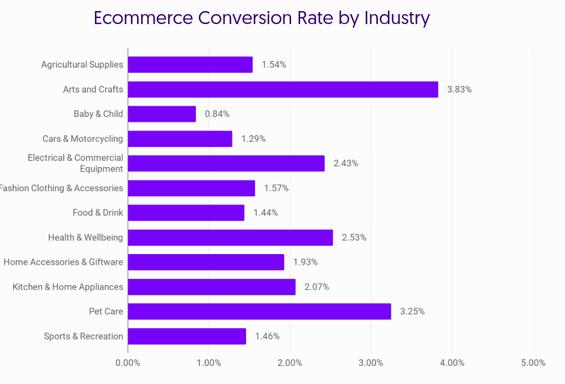
Source: irpcommerce, UK (growcode.com)
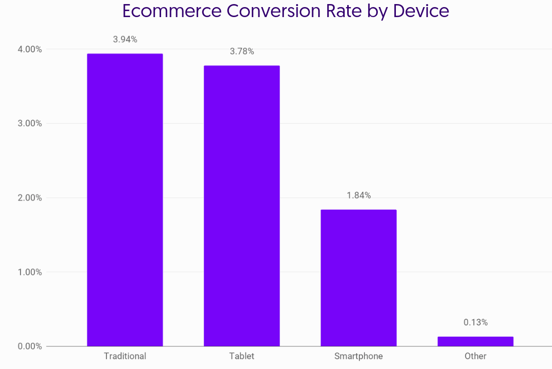
Source : Monetate (growcode.com)

Source: irpcommerce
Increase in average conversion rate by 7% to 1.65% in Mar 2019 compared to Mar 2018
How to improve conversion rate?
Average Order Value (AOV)
The aim of business through marketing is to reach out to large number of customers, increase the value of customer spending during a purchase and to increase the customer retention rate. Average order value refers to the amount of dollar spent by a customer while making a purchase. By tempting the customers to spend more during a purchase will result in increase in revenue and improve the average order value.
To calculate average order value, you can use the following formula:
Total revenue of the orders / Total number of orders taken

Source: irpcommerce (growcode.com)
Ways to improve Average Order Value
Customer Lifetime value
The total amount that the business expects to earn from its customer throughout their lifetime is the customer lifetime value. While it is an important ecommerce metrics, it is at the same time difficult to measure as the business owners should be aware of different variables like lifetime of their customers, point of time when they will leave, the frequency of their purchase and other variables. For example, your business earns $10 over 10 transactions from a customer throughout his lifetime, then your customer lifetime value for that customer would be $100 assuming your acquisition cost for this customer is 0)
To calculate customer lifetime value, you need to subtract customer acquisition cost from the revenue earned from the customers. In order to forecast customer lifetime value, you need to evaluate:
- Average Order value
- Frequency of purchase by the customers
- Lifetime of customers
Why is customer lifetime value important?
The forecast of this metric is worth it as it helps you to understand your customer cost per acquisition for improving your acquisition strategy and how much to spend on advertisement campaigns, promotions and marketing resources for customer retention.
Ways to calculate customer lifetime value
Ways to increase customer lifetime value
Customer Acquisition cost
It costs you to acquire a new customer and this amount which you spend is known as customer acquisition cost. Cost here includes expenses from marketing and sales to salaries and overhead used to attract a new customer. This metric helps you measure the effectiveness of your paid marketing efforts as all your paid traffic, do not necessarily convert to customers. Ideally in order to make profit, your customer acquisition cost should be less than customer lifetime value.
To calculate customer acquisition cost, you can use the following formula:
Total amount spent for acquisition / Total number of customers acquired
Why is customer acquisition cost important?
By analyzing customer acquisition cost, you can evaluate channels and platforms which generate higher conversion rate with minimum cost. It is a mandatory metric to evaluate the ROI of your business. It helps to direct your marketing expenditure to right places in order to earn maximum profit.
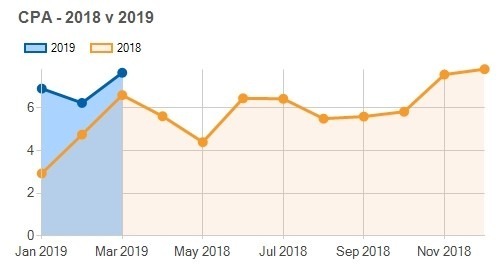
Source: irpcommerce
Increase in average CPA by 0.51% to 7.38% in Mar 2019 compared to Mar 2018
Ways to lower customer acquisition cost
Customer Retention Rate
As per a report by Adobe Digital Index, in US 40% of revenue comes from repeat purchases, which comprises for 8% of all the visitors. The report also mentions about the increase in revenue from repeat purchasers during holiday season and in times of slow economic growth. Though digital marketers understand that existing customers are more valuable than new customers, they sometimes fail to attain importance to these customers. Hence customer retention rate is an important metrics as retaining customers are more profitable than acquiring new ones. This metric gives insights on acquired customers in the past who returned back to make more purchases.
To calculate customer retention rate, you can use the following formula:
(Number of customers at the end of the period – Number of customers newly acquired during the period) / Number of customers at the start of the period
Ways to improve customer retention rate
Shopping cart abandonment rate
Cart abandonment rate refers to the percentage of customers who add items to the cart for purchase but eventually do not make a purchase. According to an ecommerce stats report by SaleCycle, the cart abandonment rate is at 75.6%.
Why is shopping cart abandonment rate important?
This is an important metric as it gives you an understanding of the inclination of the customers to make purchases. Lower the rate of cart abandonment, the better it is for the business. This metric also gives you insights of real customers and at this stage of purchase it becomes important to understand the consumer behavior to increase the conversion rate. It also helps in finding out the loopholes in the process of making purchase and resolving the pain points of potential customers.
To calculate the shopping cart abandonment, you can use the following formula:
Number of purchases completed / Number of shopping carts created
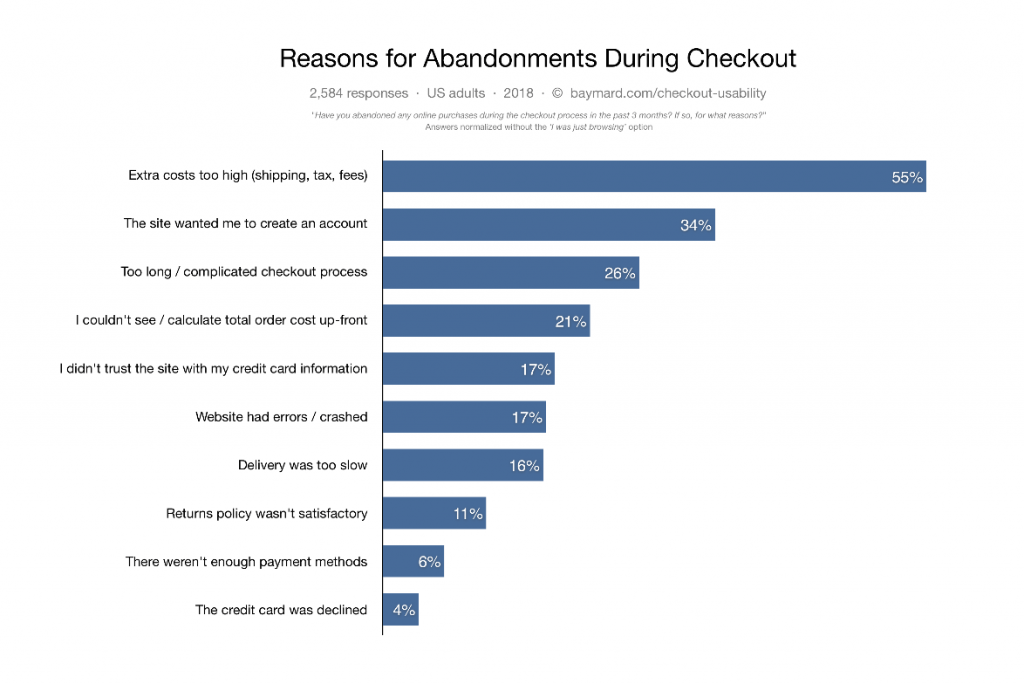
Source: Baymard Institue Cart Abandonment Statistics
Ways to improve shopping cart abandonment rate
Revenue by traffic source
The total revenue business earns through its channels like social media, paid search, organic search, referrals is the revenue by traffic. According to Wolfgang E-Commerce Benchmarks 2016 Report, Alan Coleman, Founder and CEO of Wolfgang Digital rightly says that Google and Email consists of 73% of the revenue.
The traffic from all the channels is not equal. Hence this metric is important to distinguish between traffic which is likely to bring customers and the traffic which would bring visitors in order to stop spending cash on the latter. To do so, you need to calculate the revenue from each source.
Why is revenue by traffic source important?
Revenue by traffic source as a metric would help you analyze from which traffic source you could find your target customers and what could be their potential intent to visit your site. For example, visitors coming to your website from search engine are looking out for a specific product while visitors from social media are influenced by their friends or paid ad. This metric would help you to improve your overall customer experience. You could compare your sales conversion rate coming from different traffic sources. This metric would also help you to develop a strategy to effectively utilize your marketing budget on different channels depending on revenue from traffic sources.
Ways to improve revenue by traffic source
Net Promoter Score
It is the score used to measure the customer satisfaction towards your product or services through a survey. It measures likeliness of your customer to refer your products to a friend. This survey is sent out to a customer base sample which asks them to rank on a scale of 1 – 10 of how likely they would recommend a product. Based on the results, customer base is divided into three prominent categories to target them through email marketing:
- Promoters: These are the people who give a score of 9 – 10. They are highly satisfied customers who would recommend your product. They can be potential customers who would have high retention rate.
- Neutral / Passives: These are the people who give a score of 7 – 8. These are the people who may be satisfied and may return again for repurchase.
- Detractors: These are people who give a score of 6 or less. They are not very excited about the brand and not satisfied with your service. They will have low retention rate and would not recommend your brand to others.
Why is net promoter score important?
This metric would benefit you to reach out to detractors and neutrals to get their feedback about your brand and to find out if you could do anything to improve their experience. You could also reach out to your promoters and reward them for being your loyal customers.
Ways to improve net promoter score
Social media conversion rate
The number of followers on social media would not really matter unless you are able to tap potential customers. This metrics would give you insights to analyze beyond likes, tweets, views and comments to develop a strategy for better sales. This metric would also help you to track traffic from different sources in order to understand which social media platform is bringing in visitors of desired target segment. Each post can be analyzed for their time of post, audience reach and other variables.
To calculate social media conversion rate, you can use the following formula:
Number of sales from social media / Total number of posts
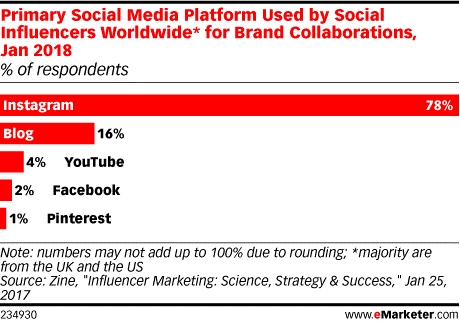
Source: eMarketer
Ways to improve social media conversion rate
Email conversion rate
Email marketing is a one-to-one marketing tool used for targeting loyal customers. In email marketing you would have more control over your subscribers to influence them as the subscribers are the promoters – they have used your products and are very satisfied with it and hence they have opted for your business updates. You would have more control over your mailing list as it is independent of other platforms like Facebook and Instagram. Though you can have an extensive list of email, you need to keep a track of total opt- in and opt-in by source. This metric is an important tool for determining the opt-in rate through email on your website.
According to a report by hubspot, email generates a revenue of $38, for every $1 spent. This accounts to 3800% ROI, making it very effective. Report also mentions that – email is a preferred way to distribute content by 93% of B2B marketers, as much as 73% of the millennials prefer business communication via email, 59% of the respondents believe that marketing emails influence their decision. According to a report by Forbes, as much as 56% of the brands using emoji as their subject line have higher open rate than others.
To calculate email conversion rate, you can use the following formula:
Number of purchases made / Total number of emails delivered successfully
Apart from these, you can keep track of these email metrics:
Subscription rate: Number of subscribers / Number of visitors
Click through rate: Number of email clicks / Number of email sent
Unsubscribe rate: Number of unsubscribe request / Number of email sent
Spam complaint: Number of complaints / Number of email sent

Source: Yes Marketing
Ways to improve email conversion rate
Website engagement
Apart from external factors like email conversion rate and social media conversion rate, your own website engagement is an important metrics to track. This ecommerce metric would give you insights on the effectiveness of your payment page and Call to Action buttons.
Apart from this you could also strategize to track:
- Session Duration
- Unique Session
- Time on page
- Bounce rate
- Returning visitors vs. new users
- Pages per session
Ways to improve website engagement
Conclusion
These are the top ecommerce metrics which you can use to track as ecommerce marketer. Though this is not an exhaustive list, it is necessary to prioritize the essentials. As long as you know the right metrics to track for your business, you can drive yourself to grow constantly.
FAQS
1. How often should ecommerce metrics be reviewed?
Ecommerce metrics should be reviewed weekly for daily performance and monthly or quarterly for broader trends and strategic adjustments.
2. What tools are available for tracking ecommerce metrics?
Popular tools include Google Analytics, Shopify Analytics, Kissmetrics, Mixpanel, and Hotjar for tracking key metrics like traffic, sales, and conversion rates.
3. How can ecommerce metrics impact customer satisfaction?
By analyzing metrics like response time, product availability, and order accuracy, businesses can improve customer experience, streamline processes, and reduce dissatisfaction.
4. What is the difference between conversion rate and click-through rate?
Conversion rate measures the percentage of visitors who complete a desired action (e.g., making a purchase), while click-through rate (CTR) measures the percentage of people who click on a link or ad.
5. How do ecommerce metrics affect inventory management?
Metrics like sales velocity and stock levels help businesses predict demand, avoid overstocking or stockouts, and manage inventory efficiently.
6. Can ecommerce metrics help in reducing cart abandonment?
Yes, analyzing abandonment rates, checkout process, and customer behavior can help identify pain points and improve the purchasing process to reduce abandonment.
7. How reliable are ecommerce metrics in predicting future trends?
Ecommerce metrics can provide valuable insights into trends, but they should be complemented with external data and market research for more accurate predictions.
8. What role do ecommerce metrics play in digital marketing strategies?
Ecommerce metrics inform digital marketing strategies by providing insights into audience behavior, ad performance, and sales funnels, helping optimize campaigns for better ROI.
9. How can businesses ensure data accuracy in ecommerce metrics?
Businesses can ensure accuracy by validating tracking codes, setting up proper integrations, monitoring data regularly, and using trusted analytics tools to minimize errors.
Sundeep Reddy is a seasoned expert in the digital marketing landscape with 15 years of comprehensive experience encompassing analytics, design, and UI/UX. As the founder of Growth Hackers, the top digital marketing agency in India for the past 7 years, Sundeep has established a reputation for innovative strategies and a results-driven approach. Recognized for his authority in the field, he’s not only led his agency to success but also actively shares his wealth of knowledge, mentoring the next wave of digital marketing professionals.

